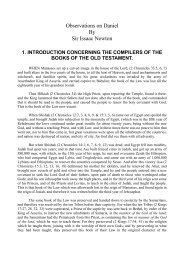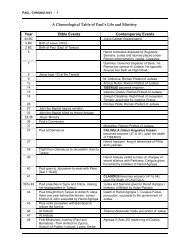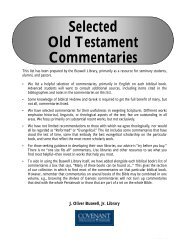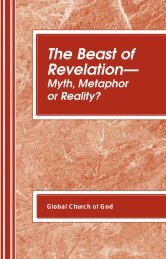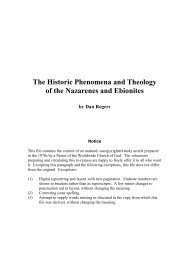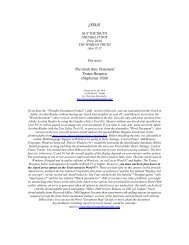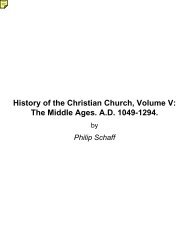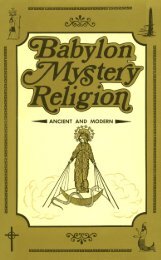by Percy E. Corbett - friendsofsabbath.org
by Percy E. Corbett - friendsofsabbath.org
by Percy E. Corbett - friendsofsabbath.org
Create successful ePaper yourself
Turn your PDF publications into a flip-book with our unique Google optimized e-Paper software.
37<br />
The tradition that Joseph of Arimathea came to Britain has been noted. With him, according to<br />
the legend, he brought the cup used <strong>by</strong> Christ at the Last Supper and, in some versions of the<br />
story, the spear that pierced his side. In Mallory's version the Grail seems to be not a drinking<br />
cup but a platter or dish from which Christ ate the Paschal Iamb the night before the<br />
Crucifixion. . . . Even if this most sacred object had been brought to Britain, or was thought to<br />
have been conveyed there, why should it feature in the story of Arthur and why should .<br />
traditions of a military commander be so bound up with the tradition of a miracle working relic ?<br />
The reason is not hard to find. He bore Christian emblems as his ensign. He was not merely<br />
a military leader but an avowedly Christian one, of the Christian faith being one of the tools<br />
with which he bound Britain into unity, and with which he opposed the forces of local loyalties,<br />
local apathies and local ambitions. Moreover, his way of life, his possessions, and his forms of<br />
worship would have been governed <strong>by</strong> the circumstances of his position as Duke of Britain.<br />
And there are good reasons presuming it likely that a Duke of Britain would have possessed<br />
and guarded such a supremely sacred relic."<br />
In Chapter XIII, Saklatvala quotes a record <strong>by</strong> William of Malmesbury (the monk who wrote his<br />
'Chronicle of the Kings of England' during the first half of the twelfth century) as follows:-<br />
"It is of Arthur that the Britons fondly tell so many fables, even to the present day; a man<br />
worthy to be celebrated, not <strong>by</strong> idle fiction, but <strong>by</strong> authentic history. He long upheld the sinking<br />
state, and roused the broken spirit of his countrymen to war.<br />
Finally, at the siege of Mount Badon, relying on an image of the Virgin, which he had affixed to<br />
his armour, he engaged nine hundred of the enemy, single handed, and dispersed them with<br />
incredible slaughter."<br />
Although I have pointed out omissions in Bede's 'Ecclesiastical History of the English Nation,' I<br />
feel that I should emphasise his valuable record of the miracles of St. Cuthbert (late 7 th<br />
century). Bede devotes sixty-two pages to 'The Life and Miracles of St. Cuthbert, which<br />
indicates the importance he gives to this record.<br />
Cuthbert lived and taught at the monastery at Lindisfarne. According to Bede, his miracles<br />
included:-<br />
The cure of a swelling on his knee <strong>by</strong> an angel.<br />
Changing the direction of winds <strong>by</strong> prayer.<br />
Seeing the soul of Bishop Arden carried to heaven <strong>by</strong> angels.<br />
Being supplied with food <strong>by</strong> God.<br />
When praying <strong>by</strong> the sea, two otters approached him, breathed upon his feet, wiped them with<br />
their hair and received his blessing.<br />
Putting out a fire <strong>by</strong> prayer.<br />
Keeping birds off a field of barley <strong>by</strong> talking to them.<br />
Changing water to the flavour of wine.<br />
Casting out devils and carrying out many healing cures.<br />
These records of miracles happening in Britain during the seventh century through the power<br />
of Christian faith are not well known and one wonders why the church does not make better<br />
use of this evidence of our Christian heritage.



